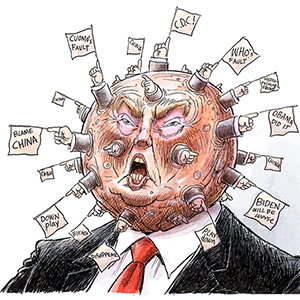S&P 500 drops most in six months on Trump tariff spat with China
Published in Business News
A months-long calm on Wall Street came to an end Friday when U.S. stocks suffered their worst selloff in six months after President Donald Trump threatened “a massive increase of tariffs on Chinese products” imported into the U.S.
The S&P 500 Index wiped out its weekly advance after tumbling 2.7%, its worst day since April 10, when the tariff-induced selloff rattled financial markets. The Nasdaq 100 Index sank 3.5%. A basket of the so-called Magnificent Seven companies plunged 3.8%, led by losses in Tesla Inc. and Amazon.com Inc. while Nvidia Corp. slid nearly 5%.
Wall Street’s chief fear gauge, the Cboe Volatility Index, or VIX, topped 20 for the first time since April — a level that typically signals mounting market stress.
Risk-on sentiment stumbled after Trump rekindled fears about an escalating trade war by saying he saw “no reason” to meet Chinese President Xi Jinping, citing recent “hostile” export controls on rare-earth minerals. Trump added that one countermeasure the U.S. is considering “is a massive increase of Tariffs on Chinese products coming into the United States of America,” adding that “There are many other countermeasures that are, likewise, under serious consideration.”
“The stock market clearly took a leg lower around the time of the ‘massive increase’ headline,” said Dan Greenhaus, chief economist and strategist at Solus Alternative Asset Management LP. “The tariff issue, for many investors, appeared settled. There was an acceptance of what has become the status quo. A ‘massive increase’ in tariffs on the country from which we import the most goods upsets that status quo and requires a rethink.”
Rising tensions between the world’s two largest economies led to widespread declines across Wall Street, with more than 420 stocks falling in the S&P 500, or roughly 84%, while just 15% of the index advanced.
Ten of the 11 sectors in the S&P 500 traded lower, led by declines in technology shares while consumer staples — a defensive area with companies that tend to have comparatively low valuations and offer robust dividends — was the lone gainer. PepsiCo Inc., housed in the staples group, was the best-performing stock in the S&P 500, rising 3.7%.
A selloff in the most speculative corners of the market led U.S. stocks lower. A Goldman Sachs basket of unprofitable tech companies fell 4.3%. The Russell 2000 Index dropped 3%, its worst day since April, while the most shorted companies lost 4.1%. A UBS basket of stocks tracking tariff losers slid 4.7%. The VVIX Index, which measures the volatility of the VIX, advanced to the highest level since April.
Among other individual stock movers, Mosaic was among the biggest S&P 500 decliners, sliding 9.2% after the fertilizer company said that third-quarter phosphate production fell below what management expected, citing mechanical issues at one plant and utility interruptions at another.
Elsewhere, Qualcomm fell 7.3% on an antitrust investigation in China over the takeover of connected-vehicle technology provider Autotalks. Applied Digital soared 16% after the firm said it’s now in advanced discussions with a hyperscaler client for its second data center campus in North Dakota.
“After one of the best rallies in history in a six-month span, it shouldn’t be much of a surprise that the market can easily catch the jitters off of headline risk,” said David Wagner, of Aptus Capital Advisors. “This is normal, but not a reason to turn pessimistic on the market.”
Now traders are turning their attention to corporate earnings, which kick off Tuesday with JPMorgan Chase & Co. and other big banks. S&P 500 profits are expected to grow by 7.4% in the third quarter from a year earlier, according to data compiled by Bloomberg Intelligence. That’s the second-highest pre-season forecast in the past four years.
(With assistance from Alexandra Semenova and Felice Maranz.)
©2025 Bloomberg L.P. Visit bloomberg.com. Distributed by Tribune Content Agency, LLC.












Comments